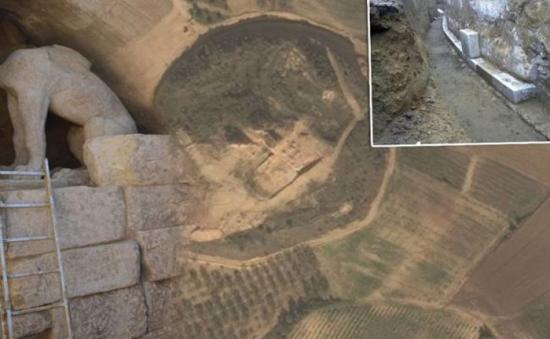Daphne
Source - http://greece.greekreporter.com/2014/08/19/revealing-the-secrets-of-ancient-amphipolis/?

The world awaits for the secrets of ancient Amphipolis to be revealed. According to the Greece ‘s Ministry of Culture and Sports, the contents of the tomb will be known by the end of the month. But what do we know so far after the discovery of the royal tomb?
Katerina Peristeri, the archaeologist in charge of the excavation of the Casta tumulus, has found that the lion and the sphinxes at the entrance were made of the same material and by the same sculptor. She believes that the buried was one of the generals or admirals in the army of Alexander the Great. Moreover, historians noted the presence of the Sphinxes in coins of that era.
The ancient sphinxes unearthed at the ancient site were recently covered in a coat of plastic to protect them from weather conditions and prying eyes. The two carved sphinxes were found after a 4.5-meter-wide path and 13 steps to the tomb, and were placed there to guard the entrance. Now, the archaeologists need to destroy the stone wall constructed to protect the tomb. Once this is done, the roof will possibly collapse, filling the tomb with dirt that will carefully be searched in order to find the grave offerings. Archaeologists also consider the possibility that the tomb has been opened and robbed in the past.
Excavations resumed today, after the long weekend of the Dormition of Virgin Mary (August 15th) holiday. With the help of a large crane, the two Sphinxes will be put aside, in order for archaeologists to get into the inside of the tomb.
The best case scenario would be for the roof to stay in place and for all treasures to be intact, in which case researchers will be able to identify the person buried there based on bones, gender and other indications. The burial chest and objects connected to the buried person’s life such as jewellery, pottery, weapons etc. would also be in the tomb provided it hasn’t been looted. The site is close to the nearby ancient Amphipolis, which was once a rich city due to its gold reserves, so the tomb artifacts may be magnificent in their splendor.
Historians doubt that it is the burial mound of Alexander the Great, but believe that a very important figure of antiquity is buried inside. The excitement of the discovery is escalating and archaeologists are working hard despite the high temperatures.
In an unprecedented move, authorities have upgraded security, with police officers guarding the site. There are rumors coming from a nearby village that speak about a large hidden treasure and looters smuggling small items.
“If it is like they say, (the discovery) will save the whole area, the whole prefecture of Serres, Macedonia and Greece,” president of the local community Athanasios Zournatzis told the Athens News Agency. Hundreds of years ago, the area was a hub of great commercial activity, with the mouth of the Strymon river frequented by kings. The ancient port, according to historians, was where Alexander the Great had started his great campaign to conquer Asia.
Ancient Amphipolis is built upon a city once known as “Enea Odoi” (Nine Roads). It was established by the Athenians in 437 BC to control the region that was rich in resources and was abandoned in the 8th Century AD. Human remains in the region date as far back as 3000 BC.
Strategically located, the area was fortified. In 480 BC, Persian King Xerxes buried nine young men and nine maidens alive as sacrifice to the river god. Only a year later, Alexander the Great was triumphant against the army of Xerxes at the battle of Amphipolis.
Athenians tried to colonize the area in the 5th century BC in order to have direct access to key raw materials such as gold and silver from the Pangaion hills. The first attempt failed when the colonists were crushed by Thracians who also wanted to control the lucrative gold mines. Athenians returned again in 437 BC and founded Amphipolis. Thucidydes states that the city was named so because the Strymon River flows around it.
During the Peloponnesian War, the Spartans captured the city but after a series of battles, Sparta was bound to return Amphipolis to the Athenians, something that never happened and caused friction.
When Philip of Macedonia came to rule, he sent a large number of Macedonian citizens to the city in order to change the composition of the population to his benefit. By the time of Alexander the Great, the seaport was very important and Amphipolis was a strategic naval base and birthplace of three major admirals – Nearcos, Androsthenes and Laomedon (a close friend of Alexander).
When the Romans took over, Amphipolis was separated from Macedonia and was incorporated into the province of Thrace. In ancient years, Amphipolis benefited from the economic boom in Macedonia and there were many beautiful churches built. Invasions by Slavs in the 6th century AD led to its depopulation and decline before it was completely abandoned.